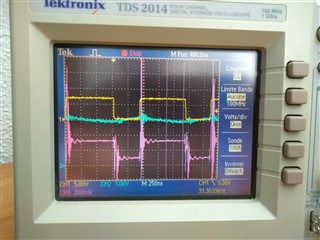Other Parts Discussed in Thread: TIDA-050002
Hi all,
I try to reach a target of 3.6 Amps to supply a high power COB LED (LED voltage up to 38V) but I stay under 3 Amps. Do you have any idea?
As the input voltage is from 16V to 48V I use the buck-boost topology and the switching frequency is set to 1MHz to minimize the system size.
I don't think the regulation loop is faulty because the signal on the voltage across R_SNS stay under 1.24V threshold and the COMP pin is around 6V. I suspect the cause is in the main switching loop, maybe it is a basics of the buck-boost topology but I don't achieve to pinpoint it.
I tried the following changes:
- R_OV1_0 value: changed to 10k to inhibit the over voltage protection.
- R_LIM value: with R_LIM=0.033R I reach 2.2 Amps, with R_LIM=0.025R 2.8 Amps but the power dissipated power increases too much.
Here the signal on Q1 gate (yellow), the current in R_SNS (blue) and the signal on IS (pink) with R_OV1_0=10k and R_LIM=0.025R

Thanks.
Guillaume.

